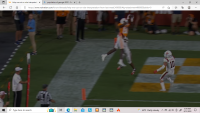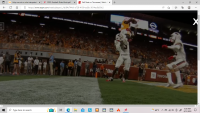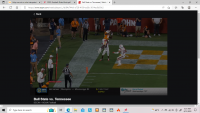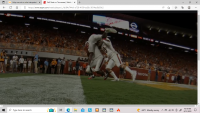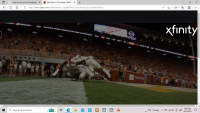GUNTERSVOL
VOL FROM BIRTH
- Joined
- Dec 30, 2017
- Messages
- 8,252
- Likes
- 11,405
While searching the rulebook for backup on OUR inbounds call for TD I came across this rule in the book that relates to last weeks play immediately after the overthrow in the endzone where Keaton went up grabbed the ball and while on the way to the ground got pushed out by two defenders. Is there a newer or superseding rule or an interpretation I am missing?
Approved Ruling 7-3-6
III. An inbounds airborne player receives a legal forward pass. While still in the air, he is tackled by an opponent and obviously held for a moment before being carried in any direction. He then lands inbounds or out of bounds with the ball. RULING: Completed pass. The ball is dead at the yard line where the receiver/interceptor was held in a manner that prevented him from immediately returning to the ground (Rule 4-1-3-p).
Here you see the catch in bounds with his momentum toward the checkerboards.....
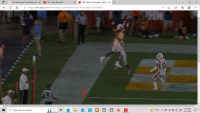
Then the two guys push him out a few feet to the boundry as he is returning to the ground. Looks HELD to me... Notice the legs of the defender buckling from his weight. HELD? That is the question. Not just incidental contact.
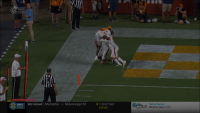
Bad call or not? Talking heads lauded the defensive players for a headsup play, but what about the refs?
Approved Ruling 7-3-6
III. An inbounds airborne player receives a legal forward pass. While still in the air, he is tackled by an opponent and obviously held for a moment before being carried in any direction. He then lands inbounds or out of bounds with the ball. RULING: Completed pass. The ball is dead at the yard line where the receiver/interceptor was held in a manner that prevented him from immediately returning to the ground (Rule 4-1-3-p).
Here you see the catch in bounds with his momentum toward the checkerboards.....

Then the two guys push him out a few feet to the boundry as he is returning to the ground. Looks HELD to me... Notice the legs of the defender buckling from his weight. HELD? That is the question. Not just incidental contact.

Bad call or not? Talking heads lauded the defensive players for a headsup play, but what about the refs?
Last edited:



